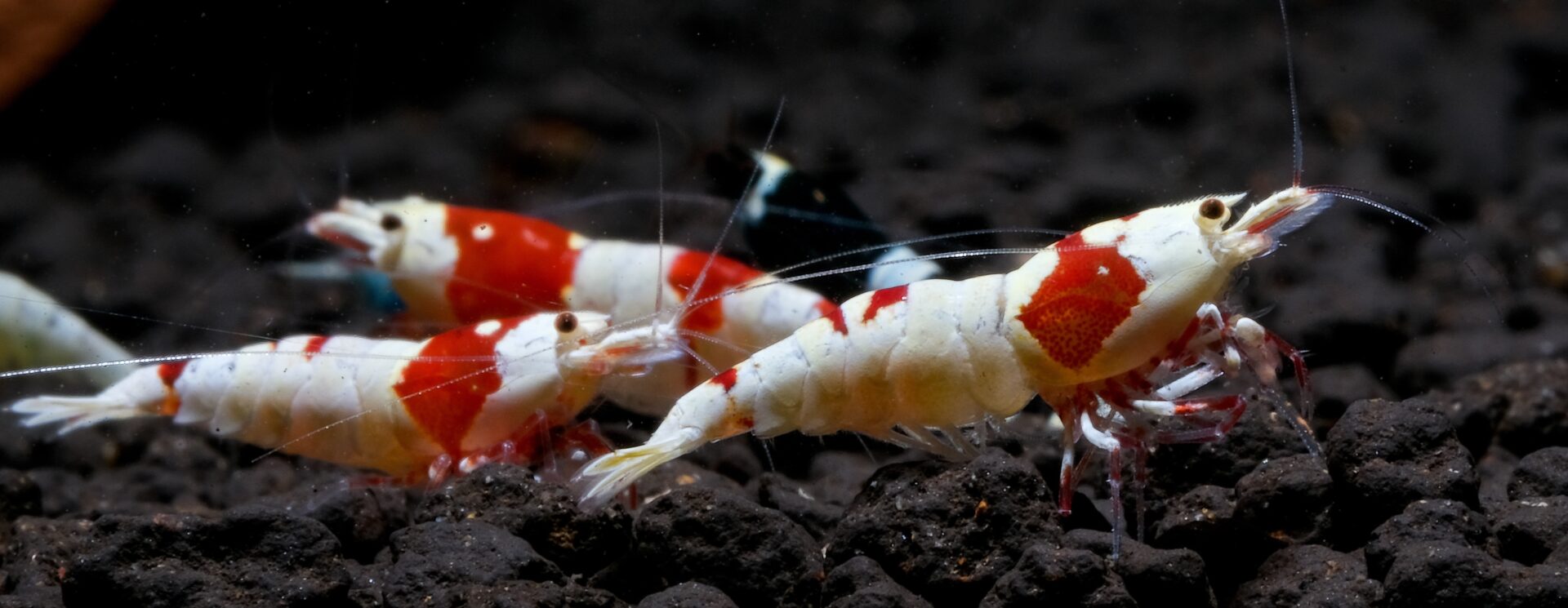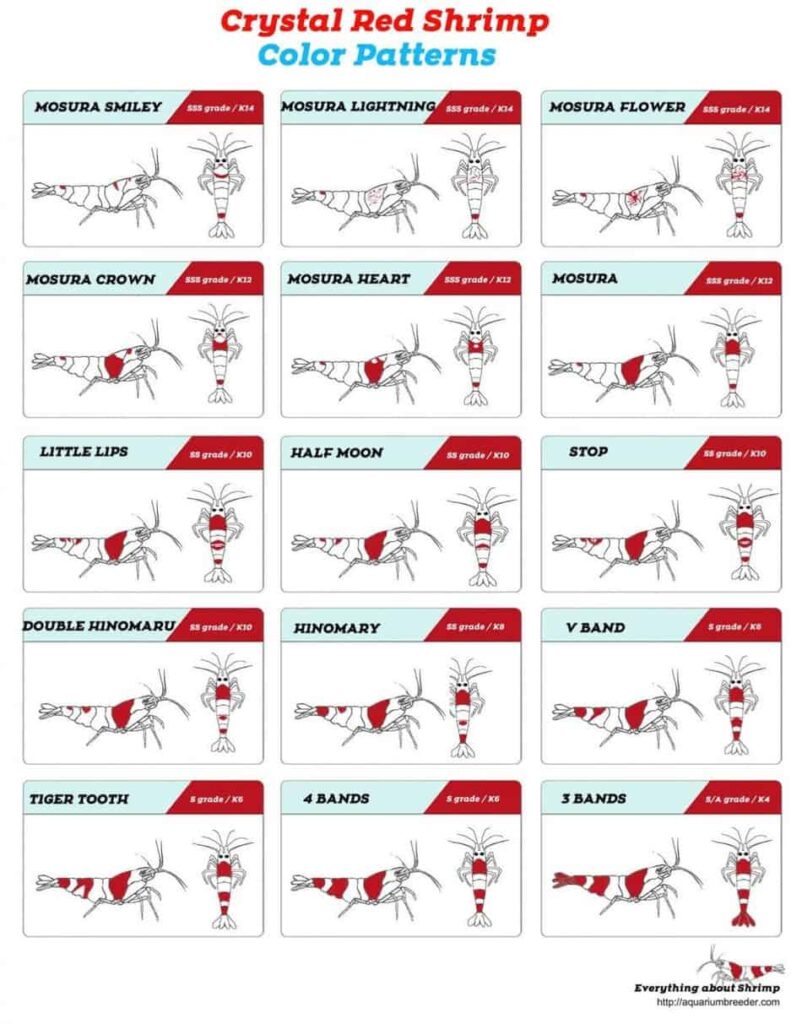Caridina Pure Red Line Shrimp (PRLs)
Brief Description of Caridina Pure Red Line Shrimp (PRLs) Appearance
Caridina pure red line shrimp, commonly referred to as PRLs, are a strikingly beautiful variety of freshwater shrimp known for their vivid red and white coloration. These small, ornamental shrimp are characterized by their clear, sharp lines of bright red contrasted with pure white patches, creating a visually appealing, candy-cane-like pattern. Their striking appearance makes them a popular choice among shrimp enthusiasts and aquarists.
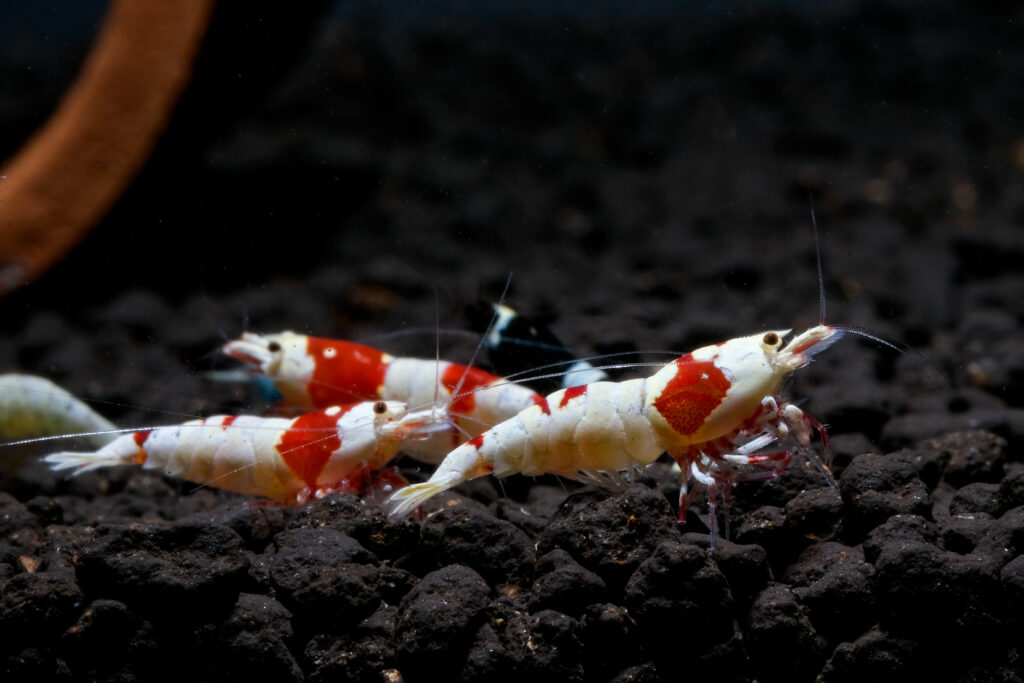
Scientific Name and Classification
The scientific name for Caridina pure red line shrimp is Caridina cantonensis. They belong to the family Atyidae, which includes a variety of freshwater shrimp species. PRLs are a selectively bred variant of the Crystal Red Shrimp, a well-known species within the genus Caridina.
Origin and Natural Habitat
Pure Red Line (PRL) shrimp are a selectively bred variety that do not exist in the wild. They originate from Japan, where skilled breeders developed them through careful selection of Crystal Red Shrimp (CRS). They are a color morph bred from the wild Caridina cantonensis, native to streams and rivers in southern China and Taiwan. In their natural habitat, C. cantonensis are typically brown or transparent, adapted to soft, slightly acidic waters with abundant vegetation.
Physical Appearance, Size, and Lifespan
PRLs are small, typically growing to about 1.2 to 1.5 inches (3 to 4 cm) in length. They have a cylindrical body covered in a hard exoskeleton, which they periodically molt as they grow. Their most distinctive feature is their coloration, with the red and white pattern being a key indicator of their purity and quality. Under optimal care conditions, Caridina pure red line shrimp can live up to 1.5 to 2 years, although their lifespan may vary based on environmental factors and overall health.
History of Caridina Pure Red Line Shrimp (PRLs)
Development Through Selective Breeding
The development of Caridina pure red line shrimp is a result of meticulous selective breeding aimed at enhancing their color and pattern. This breeding process began with the Crystal Red Shrimp, a naturally occurring red variant of the Bee Shrimp (Caridina cantonensis). Breeders in Taiwan focused on intensifying the red pigmentation and refining the clarity of the white bands, eventually creating the distinct PRL variety. This selective breeding ensured that only shrimp with the most desirable traits were propagated, leading to the high-quality PRLs available today.
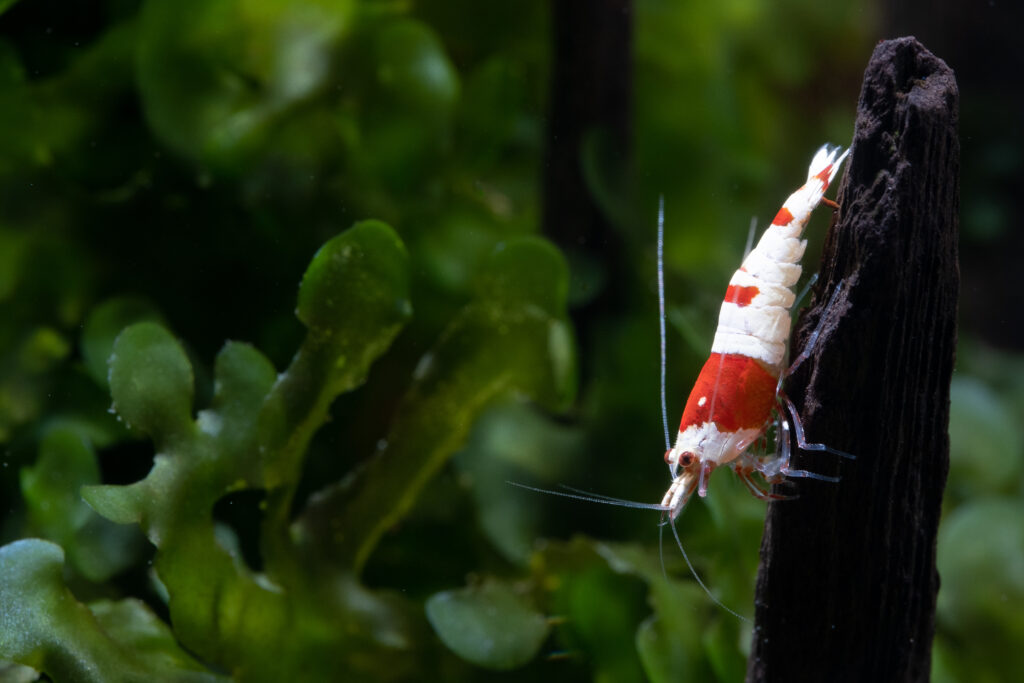
Relation to Crystal Red Shrimp
Caridina pure red line shrimp are closely related to Crystal Red Shrimp (CRS), sharing the same species, Caridina cantonensis. PRLs are essentially an enhanced version of CRS, developed to exhibit even more vibrant colors and sharper patterns. While both varieties are prized for their beauty, PRLs are often considered the pinnacle of selective breeding efforts, with higher standards of color purity and pattern consistency. PRLs are often classified if their offspring do not contain any Snow White, or other variant shrimp. They should produce offspring that are 100% true to their lineage.
Popularity in the Aquarium Hobby
PRLs have gained immense popularity in the aquarium hobby due to their striking appearance and the challenge they present to breeders and hobbyists. Their vibrant colors and unique patterns make them a standout addition to any freshwater aquarium. Additionally, the meticulous care required to maintain their ideal water parameters and health has created a dedicated community of enthusiasts who take pride in breeding and showcasing these exquisite shrimp. As a result, PRLs have become a symbol of excellence and dedication in the world of ornamental shrimp keeping.
Caridina Pure Red Line Shrimp (PRLs) Care and Ideal Water Parameters
Caring for Caridina pure red line shrimp requires maintaining specific water parameters to ensure their health and coloration. The ideal conditions for PRLs are as follows:
- Total Dissolved Solids (TDS): 100-120 ppm
- pH: 5.4-6.2
- General Hardness (GH): 4-5 dGH
- Carbonate Hardness (KH): 0-1 dKH
- Temperature: 60-72°F (15-22°C)
These parameters mimic the soft, slightly acidic waters of their natural and selective breeding environments. Maintaining stable and clean water conditions is crucial for the well-being of PRLs. Regular monitoring and adjustments, along with a well-established aquarium with minimal fluctuations, will help keep these delicate shrimp healthy and vibrant. Proper care also includes providing a balanced diet, sufficient hiding spots, and avoiding any exposure to harmful chemicals or pollutants in the water.
Setting Up a Successful Caridina Pure Red Line Shrimp (PRLs)
Tank Size Recommendations
For Caridina pure red line shrimp, the tank starts at 10 gallons (38 liters), and a minimum of 5 gallons (19 liters). While these shrimp are small, they thrive in stable environments, and larger tanks help maintain consistent water parameters. A larger tank also provides more space for the shrimp to explore and reduces the risk of overcrowding, which can lead to stress and poor health.
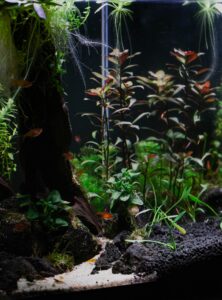 Filtration Options (Focus on Sponge Filters)
Filtration Options (Focus on Sponge Filters)
Sponge filters are highly recommended for PRL shrimp tanks. These filters provide gentle, efficient filtration without creating strong currents that can stress the shrimp. Sponge filters also offer a large surface area for beneficial bacteria to colonize, which is crucial for maintaining water quality. Additionally, they are shrimp-safe, preventing the tiny shrimp from being sucked into the filter.
Substrate Choices
The substrate in a PRL shrimp tank should be chosen carefully to maintain optimal water parameters. Active substrates, such as ADA Aqua Soil or similar products, are ideal as they help maintain a slightly acidic pH and soft water conditions. These substrates also promote the growth of beneficial bacteria, further enhancing the tank’s stability.
Importance of Hiding Places and Plants
Hiding places and plants are essential in a PRL shrimp tank. They provide shelter, reduce stress, and offer areas for the shrimp to forage. Live plants like Java moss, Anubias, and Bucephalandra are excellent choices as they also help maintain water quality by absorbing nitrates. Adding driftwood, rocks, and shrimp tubes creates additional hiding spots and enhances the tank’s natural look.
Acclimation Process
Proper acclimation is crucial when introducing PRLs to a new tank. The drip acclimation method is recommended to gradually adjust the shrimp to the new water parameters. Start by placing the shrimp and their transport water in a container. Use airline tubing to slowly drip tank water into the container over a period of 1-2 hours, gradually doubling the water volume. This slow process helps prevent shock and stress, increasing the chances of successful acclimation.
Diet and Feeding
Natural Feeding HabitsIn their natural habitat, Caridina pure red line shrimp are omnivorous scavengers. They feed on biofilm, algae, decaying plant matter, and small microorganisms. This varied diet helps them obtain essential nutrients for growth and color development.
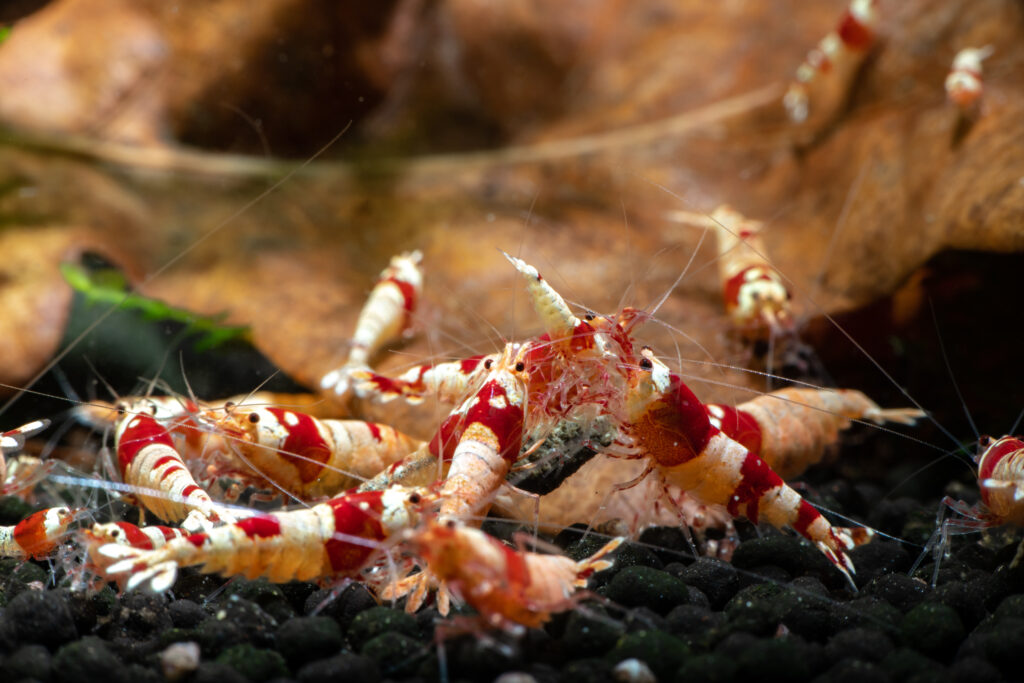
Recommended Commercial Foods
High-quality commercial foods specifically formulated for Caridina shrimp are recommended for daily feeding. Brands such as Bacter AE, Shrimp King Complete, and Hikari Shrimp Cuisine provide balanced nutrition, promoting healthy growth and vibrant coloration. These foods are designed to mimic the natural diet of the shrimp and contain essential vitamins and minerals.
Supplemental Foods (Vegetables, Leaves, etc.)
Supplemental foods are a great way to diversify the diet of PRL shrimp. Blanched vegetables like zucchini, spinach, and kale are excellent choices, providing additional nutrients and fiber. Indian almond leaves and oak leaves can also be added to the tank. These leaves decompose slowly, releasing beneficial tannins and serving as a long-term food source.
Feeding Frequency and Amount
Feed 2-3 times a week, an amount that the shrimp can consume within 1-2 hours. Avoid overfeeding to maintain water quality and prevent food from fouling the tank.
Understanding Caridina Pure Red Line Shrimp (PRLs)
Basic Principles of Caridina Pure Red Line Shrimp (PRLs) Grading
Grading PRL shrimp involves assessing their color intensity, pattern clarity, and overall appearance. Higher grades exhibit more vivid red coloration and cleaner, more distinct white bands. The grading system typically ranges from lower grades (C, B) to higher grades (SSS, Extreme), with the highest grades being the most sought after for their exceptional beauty.
Importance of Grading in Breeding and Sales
Grading is crucial in the breeding and sales of PRL shrimp as it determines their value and desirability. Higher-grade shrimp are often used in selective breeding programs to produce offspring with superior traits. In the marketplace, higher-grade shrimp command higher prices due to their rarity and aesthetic appeal. Understanding grading helps breeders and hobbyists set realistic expectations and achieve their desired breeding outcomes.
For a detailed guide on grading Caridina pure red line shrimp, visit our Caridina grading guide.
Color Grading
Description of Different Color Grades
Caridina pure red line shrimp (PRLs) are graded based on the intensity and coverage of their red and white colors. The grading system typically includes:
C: Shrimp has mostly solid red/black body with minimal white. Colors appear washed out.
B: Faint white stripes but red/black is still dominant. Lacks color vibrancy.
A: Even amounts of white and red/black. White has decent opacity, red/black appears blotchy.
S: White is the primary color. Red/black areas are solid/intense. Some patchiness between colors.
SS: Very intense, evenly spread opaque white. Solid vivid red/black remains on segments. Non-transparent leg coloration.
SS+: Solid white dominates with even less transparency than SS grade. Clean colors. Solid leg coloration.
SSS: Virtually no transparent spots on the shell – shrimp is an opaque pure white with minimal red/black patterns. Leg coloration is equally as clean and thick.
SSS+: Considered an ideal specimen with seamless solid white to the naked eye, no transparency whatsoever. Vivid and distinct red/black patterns. 100% colored legs.
Factors Affecting Color Intensity
Several factors influence the color intensity of PRL shrimp:
- Genetics: Selective breeding for vibrant colors ensures that high-grade shrimp produce offspring with desirable traits.
- Diet: A balanced diet rich in carotenoids and other nutrients enhances color development. Foods like Spirulina and specially formulated shrimp pellets are beneficial.
- Water Quality: Maintaining ideal water parameters (pH, GH, KH, and TDS) helps preserve the shrimp’s coloration. Clean, stable water conditions are essential for maintaining their vibrant colors.
- Light: Adequate lighting in the aquarium can influence color intensity, with moderate light often bringing out the best in PRLs without causing stress.
For a comprehensive guide on grading Caridina pure red line shrimp, check out our detailed Caridina pure red line shrimp grading guide.
Pattern Grading
Intro to Types of Patterns
Caridina pure red line shrimp exhibit a variety of patterns that contribute to their grading:
- No Entry: Characterized by a solid white head with a red “no entry” sign pattern on the back. It’s one of the most unique patterns.
- Hinomaru: Features a large red spot on the shrimp’s back, resembling the Japanese flag. Variations include single or double Hinomaru.
- Mosura: Primarily white shrimp with a red head and tail, and possibly red spots or patches. The Mosura pattern is highly prized for its beauty and rarity.
Rarity and Value of Different Patterns
The rarity and value of PRL shrimp patterns vary significantly:
- No Entry: Quite rare and highly valued for its distinctive marking.
- Hinomaru: Popular and valuable, especially the double Hinomaru variation.
- Mosura: One of the most sought-after patterns, with high value due to its striking appearance and the challenge of breeding for this pattern consistently.
Patterns greatly affect the shrimp’s market value and breeding desirability, with more complex and rare patterns commanding higher prices and greater interest from hobbyists and breeders.
For a detailed guide on the various patterns of Caridina pure red line shrimp, visit our detailed Caridina pure red line shrimp grading guide.
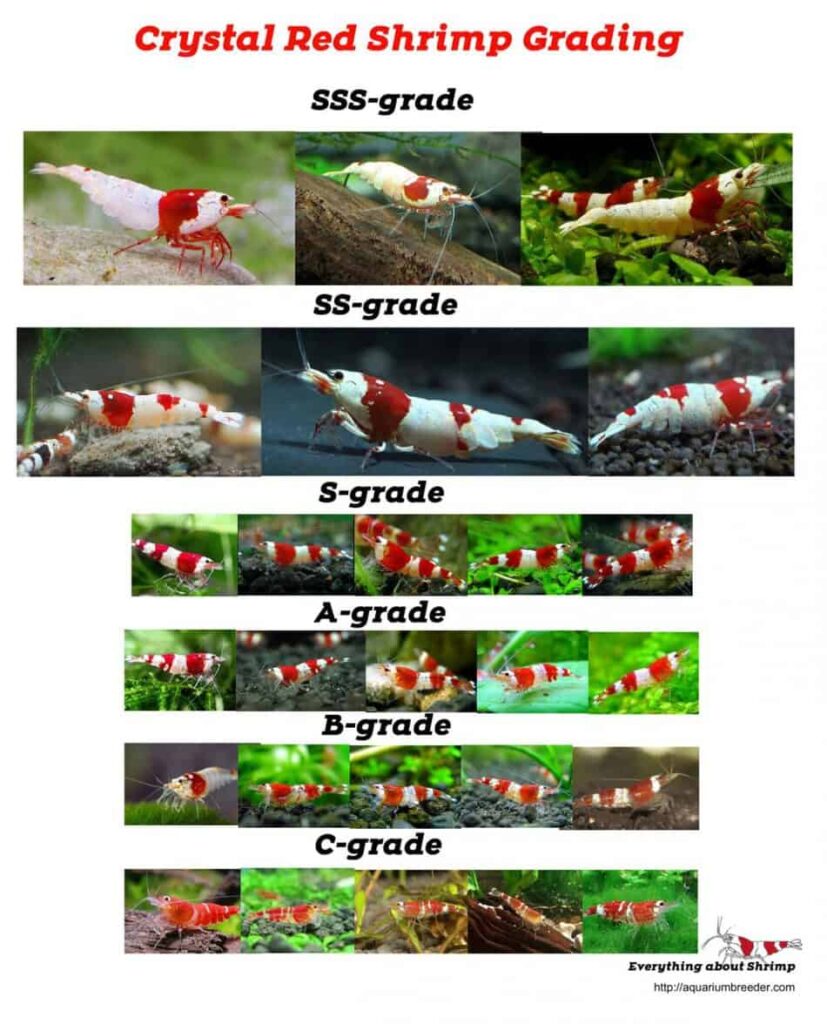
Breeding Caridina Pure Red Line Shrimp (PRLs)
Breeding Setup Requirements
To successfully breed Caridina pure red line shrimp, you need:
- Tank Size: A minimum of 10 gallons, but larger is better for stability.
- Filtration: A sponge filter to provide gentle filtration without harming the shrimp.
- Substrate: Active substrate to maintain ideal water parameters.
- Plants and Hiding Spots: Live plants like Java moss and plenty of hiding places to reduce stress and provide areas for shrimplets to hide.
- Water Parameters: Maintain pH 5.4-6.2, GH 4-5, KH 0-1, TDS 100-120, and temperature 60-72°F.
Mating Behavior
PRLs reach sexual maturity around 4-6 months old. When a female is ready to mate, she releases pheromones that attract males. The males will actively swim around the tank searching for the receptive female. Once found, the male will mate with her, and she will carry fertilized eggs under her abdomen.
Egg Development and Hatching
The female PRL shrimp will carry the eggs, known as being “berried,” for about 28-30 days. During this period, she regularly fans the eggs with her pleopods to ensure they receive enough oxygen. The eggs gradually develop and darken as hatching approaches. When ready, the fully formed shrimplets hatch and are miniature versions of the adults.
Care for Shrimplets
Caring for shrimplets requires attention to detail:
- Water Quality: Maintain pristine water conditions as shrimplets are sensitive to fluctuations.
- Food: Provide fine powdered food like Bacter AE or specialized shrimp baby food. Ensure food particles are small enough for the shrimplets to consume.
- Hiding Spots: Dense plant growth and moss provide essential cover and surfaces for biofilm growth, which is a primary food source for young shrimp.
With careful attention to their environment and diet, shrimplets will grow and develop into healthy adults, continuing the cycle of breeding and maintaining the lineage of Caridina pure red line shrimp.
Common Health Issues and Treatments
Signs of Stress or Illness
Identifying signs of stress or illness in Caridina pure red line shrimp (PRLs) is crucial for maintaining their health. Common indicators include:
- Lethargy or reduced activity
- Loss of coloration or faded colors
- Erratic swimming behavior
- Visible parasites or abnormalities on the body
- Failure to molt properly or frequent unsuccessful molts
- Loss of appetite
Common Diseases and Parasites
Several diseases and parasites can affect PRLs:
- Bacterial Infections: Often manifested by cloudy or opaque patches on the shrimp’s body. These can be caused by poor water quality or injuries.
- Fungal Infections: Appear as white, cotton-like growths on the body. These usually occur in tanks with high organic matter and poor water conditions.
- Parasitic Infections: Common parasites include Vorticella (white fuzz) and Scutariella (white worm-like structures on the head).
- Planaria: Flatworms that can harm shrimp by feeding on eggs and weak individuals.
Prevention and Treatment Options
- Prevention: Maintaining pristine water quality, performing regular water changes, and providing a balanced diet are key preventive measures. Avoid introducing contaminated plants, decorations, or new shrimp without proper quarantine.
- Treatment: For bacterial infections, use antibacterial medications like Seachem Kanaplex. Fungal infections can be treated with antifungal medications or salt baths (with caution). Parasitic infections often require specific treatments like Planaria traps, No Planaria, or similar shrimp-safe treatments. Regular tank maintenance and observing shrimp behavior are crucial for early detection and effective treatment.
Compatible Tank Mates
Suitable Shrimp Species
Caridina pure red line shrimp can be kept with other peaceful shrimp species that thrive in similar water conditions, such as:
- Crystal Red Shrimp (Caridina cantonensis): They share similar requirements and can coexist harmoniously.
- Bee Shrimp (Caridina cantonensis): Including varieties like Blue Bolt or Black King Kong shrimp.
Compatible Fish Species
When choosing fish tank mates, opt for small, non-aggressive species that are unlikely to prey on shrimp:
- Otocinclus Catfish: These small algae-eaters are peaceful and won’t harm shrimp.
- Small Tetras: Such as Ember Tetras, which are small and non-aggressive.
- Rasboras: Especially species like the Harlequin Rasbora, known for their calm temperament.
No fish are not recommended in a breeding colony.
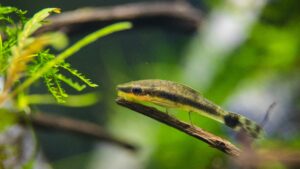
Species to Avoid
Avoid fish that are known to prey on shrimp or are too aggressive:
- Large or Aggressive Fish: Such as Cichlids, Betta fish, or Angelfish.
- Bottom-Dwelling Predators: Like Loaches or large Catfish, which may hunt shrimp.
FAQs
Can Caridina Pure Red Line Shrimp (PRLs) Be Kept with Crystal Red Shrimp?
Yes, Caridina pure red line shrimp can be kept with Crystal Red Shrimp. They share similar water parameter requirements and temperaments, making them compatible tank mates.
Can Caridina Pure Red Line Shrimp (PRLs) Be Kept with Fish?
PRLs can be kept with small, non-aggressive fish species. It’s important to choose fish that won’t prey on the shrimp or compete aggressively for food. No fish are not recommended in a breeding colony.
How Long Do Caridina Pure Red Line Shrimp (PRLs) Live?
Under optimal conditions, Caridina pure red line shrimp typically live for 1.5 to 2 years. Their lifespan can be influenced by water quality, diet, and overall care.
How Often Do Caridina Pure Red Line Shrimp (PRLs) Molt?
PRLs molt approximately every 3 to 6 weeks, depending on their age, health, and environmental conditions. Molting frequency can increase during periods of rapid growth or stress.
What Causes Caridina Pure Red Line Shrimp (PRLs) to Lose Color?
Several factors can cause PRLs to lose color:
- Stress: From poor water quality, inappropriate water parameters, or aggressive tank mates.
- Inadequate Diet: Lack of nutrients essential for maintaining vibrant coloration.
- Poor Water Quality: High levels of ammonia, nitrites, or nitrates can stress shrimp and lead to color loss.
- Genetic Factors: Some shrimp may naturally have less intense coloration.
Buying Guide
How to Spot Healthy Shrimp
When purchasing Caridina pure red line shrimp (PRLs), it’s essential to identify healthy specimens to ensure they thrive in your aquarium:
- Active Behavior: Healthy shrimp are active, constantly foraging, and exploring their environment.
- Vibrant Colors: Look for bright red and white coloration without any dull or faded areas.
- Clear Eyes: Shrimp should have clear, bright eyes. Cloudy or sunken eyes can be a sign of illness.
- Smooth Exoskeleton: The exoskeleton should be free of spots, discolorations, or signs of damage.
- Proper Molting: Check for any issues with molting, such as incomplete molts or difficulty shedding their exoskeleton.
Selecting the Best Specimens
When selecting PRLs, consider the following factors to choose the best specimens:
- Grade and Pattern: Choose shrimp with the highest grade and most desirable patterns, such as Hinomaru or Mosura, if your goal is to breed or showcase high-quality shrimp.
- Size and Age: Opt for juvenile or young adult shrimp, as they adapt better to new environments and have a longer potential lifespan.
- Source: Select shrimp from reputable breeders or stores known for their healthy stock and good breeding practices.
Reputable Sources for Purchasing Caridina Pure Red Line Shrimp (PRLs)
To ensure you get high-quality PRLs, purchase from:
- Specialized Breeders: Look for breeders who specialize in Caridina shrimp and have a good reputation within the shrimp-keeping community. Target reputable lineages. In breeding colonies, purebred or near purebred lineages are vital to ensure consistent offspring and predictable gene inheritance, free from genes of other variants.
- Reputable Online Stores: Trusted online retailers with positive reviews and a history of selling healthy shrimp.
- Local Fish Stores: If they have a good selection of Caridina shrimp and knowledgeable staff, they can be a reliable source.
Shipping Considerations
When ordering PRLs online, consider the following shipping factors:
- Packaging: Ensure the seller uses proper packaging, including insulated boxes and heat or cold packs if necessary, to maintain stable temperatures during transit.
- Shipping Speed: Choose express shipping options to minimize transit time and stress on the shrimp.
- Acclimation Instructions: Follow the seller’s acclimation instructions carefully upon arrival to ensure a smooth transition for the shrimp into your tank.
Advanced Caridina Pure Red Line Shrimp (PRLs) Keeping
Selective Breeding Techniques
Selective breeding involves choosing the best specimens with desirable traits to produce offspring with enhanced qualities. Key techniques include:
- Pairing High-Quality Shrimp: Select shrimp with the best color, pattern, and health for breeding.
- Isolating Breeding Pairs: Keep breeding pairs in separate tanks to control mating and ensure only the desired traits are passed on.
- Recording Lineages: Maintain detailed records of breeding pairs and their offspring to track genetic traits and avoid inbreeding.
Creating Unique Color Morphs
Advanced hobbyists may experiment with creating unique color morphs:
- Cross-Breeding: Combine different color and pattern variations to produce new, unique morphs.
- Consistent Selective Breeding: Focus on breeding shrimp with subtle variations in color or pattern over several generations to solidify new traits.
- Experimentation: Be patient and willing to experiment, as developing new color morphs can take time and careful planning.
Participating in Shrimp Competitions
Shrimp competitions offer an opportunity to showcase your PRLs and gain recognition:
- Preparation: Ensure your shrimp are in peak condition, with vibrant colors and patterns.
- Documentation: Provide detailed records of your shrimp’s lineage and breeding history.
- Networking: Participate in competitions to meet other enthusiasts, exchange knowledge, and learn new techniques to improve your breeding practices.
Caridina pure red line shrimp (PRLs) are a captivating addition to any freshwater aquarium, admired for their vibrant colors and intricate patterns. Proper care involves maintaining pristine water conditions, providing a balanced diet, and carefully selecting tank mates. Advanced enthusiasts can engage in selective breeding to enhance shrimp quality and participate in competitions to showcase their efforts.
With dedication and attention to detail, keeping PRLs can be a rewarding and enjoyable experience. Whether you are a beginner or an experienced aquarist, these stunning shrimp offer endless opportunities for learning and growth in the hobby. Dive into the world of PRLs and discover the joy of maintaining and breeding these beautiful creatures.

